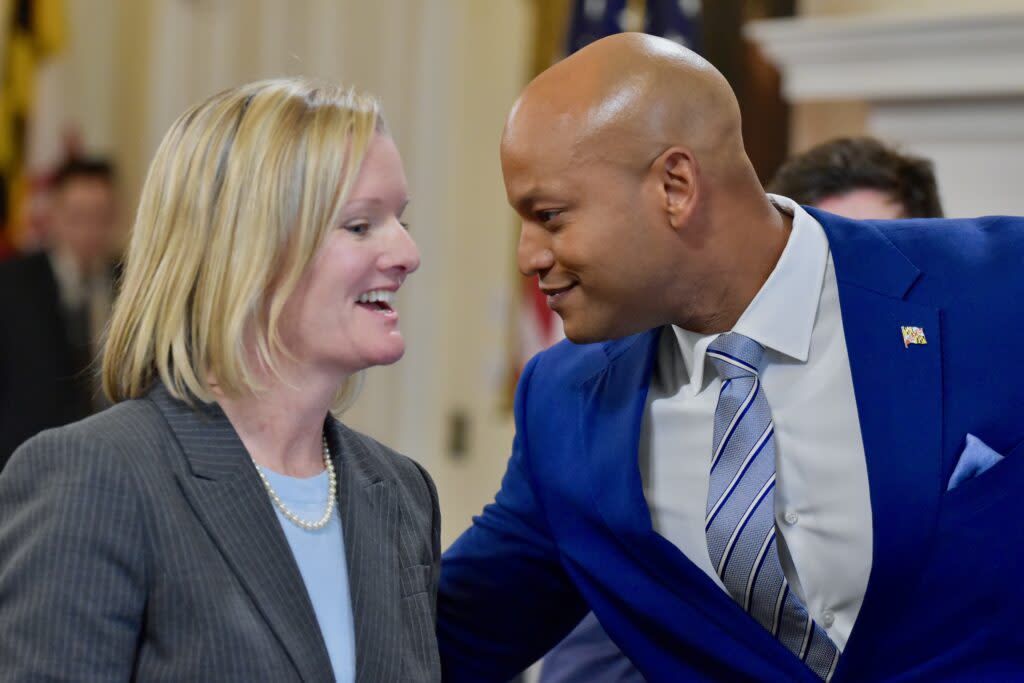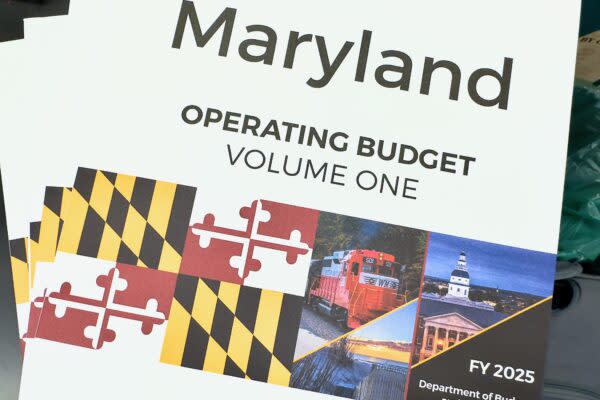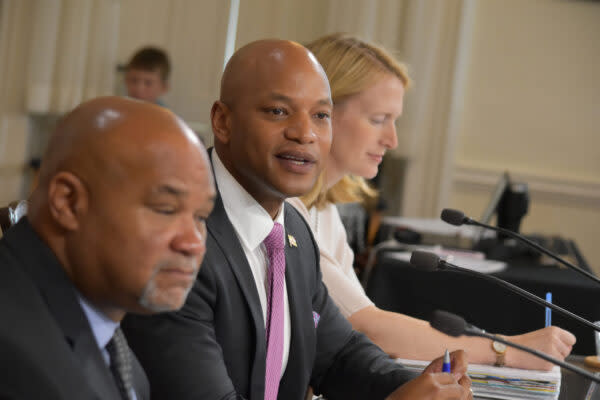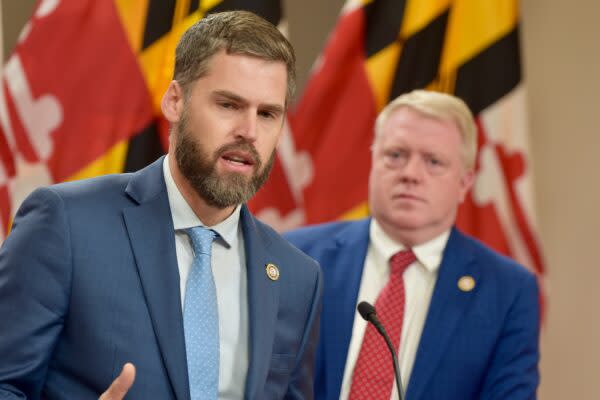Moore proposes nearly $150 million in budget cuts

Maryland Budget Secretary Helene Grady and Gov. Wes Moore (D). Photo by Bryan P. Sears.
Gov. Wes Moore (D) will ask the Board of Public Works to adopt nearly $150 million in cuts to the state’s current budget of $63 billion.
Administration officials said Wednesday that higher-than-anticipated Medicaid enrollment and continued growth in a state-subsidized child care program, coupled with a stagnant economy and a flat revenue outlook, were key drivers of the proposed reductions. They said the cuts, announced just 10 days into fiscal 2025, are needed to be proactive and make early spending adjustments.
The plan was unveiled in an online post Wednesday. Moore, who is at the Sun Valley Conference in Idaho this week — an event sometimes called “billionaires’ summer camp” — touted the plan in a Baltimore Sun op-ed Wednesday as a tough, fiscally responsible decision.
“This morning, my administration submitted a plan to make targeted and strategic spending cuts and grow our economy while simultaneously protecting the programs and projects that Marylanders care about most,” Moore wrote in the piece. “We’ve taken a disciplined, data-driven approach that prioritizes investment in areas that connect Marylanders with employment and build new pathways to work, wages, and wealth for all.”
Republican leaders welcomed the fact that the administration is not calling for more taxes or fees to fix the budget, but said Moore’s plan is “not exactly an act of courage” given longer-term fiscal challenges the state faces.

“It is going to take more than swapping dollars around to address our fiscal challenges,” House Minority Whip Jesse T. Pippy (R-Frederick) said in a statement. “There must be an acknowledgment that some of these grand promises, like the Red Line and the Blueprint (for Maryland’s Future, the education reform plan) are not financially realistic.”
Moore’s plan calls for no furloughs or layoffs or rollbacks of salary increases for employees. It will, however, delay hiring for many state positions.
In a briefing with reporters Wednesday, administration officials said higher than expected Medicaid participation are one reason for the proposed cuts. Slightly fewer than 1.7 million Marylanders are currenlty on the Medicaid rolls, just below the peak pandemic enrollment. Those same officials said it is possible the new enrollment figures represent a new normal.
When the Department of Legislative Services identified higher than expected Medicaid costs earlier this year, legislative leaders responded by giving Moore authority to draw on nearly $200 million from the state’s rainy-day fund between just-ended fiscal 2024 and fiscal 2025.
Administration officials said Wednesday that the state will tap the $90 million set aside for fiscal 2024, which ended June 30, but that it is too soon to know if it will tap another $100 million earmarked for fiscal 2025.
A second driver is enrollment in state-subsidized childcare: Enrollment stood at 24,000 children in January 2o23, when Moore took office, and was expected to be between 30,000 and 40,000 children in the coming year. But it was nearly 41,000 in June, and officials said they expect the numbers may continue to climb.
Officials told reporters the child care and Medicaid programs are seen as key to driving economic growth, and Moore’s focus on growing the economy will supplant other priorities, including hiring state workers.
Proposal needs approval of three-member board
The proposed cuts will require the approval of the Board of Public Works that is chaired by Moore and includes Comptroller Brooke Lierman and Treasurer Dereck Davis, both Democrats. The board will next meet on July 17.
The board’s primary function is approving state contracts, but it can also cut the budget by as much as 25% when the legislature is not in session.

Former Gov. Martin O’Malley (D), grappling with a recession in 2015, got the board to approve a $200 million reduction — about 2% of the fiscal 2015 budget. Then-Gov. Larry Hogan (R) sought more than $670 million in reductions at the start of the fiscal year as the state and nation faced the economic challenges of the COVID-19 pandemic in 2020. The board at the time, which included two Democrats, approved $413 million in cuts.
Wednesday’s announcement of proposed reductions is required by a 2016 law that requires the governor to announce details of any proposed cuts to give the public an chance to react. Proposed cuts must be made public three days before the Board of Public Works meets to consider approval.
Budget challenges loom
Maryland faces several budget challenges in the coming years, when legislative budget analysts have projected that a structural budget gap between revenues and spending would balloon to $3 billion.
This figure included a projected $1 billion next year. In fiscal 2027, the last year of Moore’s term, it would grow to $1.3 billion before more than doubling a year later to $3 billion — about 12% of general fund revenues projected for that year.
The deficit projections are the largest since the Great Recession, the budget analysts say.
They are mostly driven by escalating costs of the Blueprint for Maryland’s Future K-12 education plan. On top of that are Moore’s ambitious, if not yet fully budgeted, visions to end child poverty and build the east-west Red Line transit system in Baltimore.
Moore also faces billions of dollars in shortfalls in the Transportation Trust Fund. And the state will need to rebuild the Francis Scott Key Bridge, which collapsed on March 26.
President Joe Biden has promised full federal funding for the project, which is currently projected to cost about $1.7 billion, but the effort to secure 100% funding for the bridge is stalled in Congress.
“Just a few weeks ago Governor Moore announced the resurrection of the Red Line, something that will dry up our already-scarce transportation dollars,” Pippy’s statement said. “Only 10 days ago, the latest round of fee hikes went into effect.”
The looming fiscal pressures sparked a heated debate over taxes this year between House and Senate leaders, with the House proposing a $1.2 billion package of taxes and tolls and the Senate rejecting calls for broad-based tax increases. Moore has also been hesitant to push for tax increases.
In the end, the two sides agreed to a plan that included targeted fees and increases in vehicle registration costs and surcharges for electric vehicles.

Senate President Bill Ferguson (D-Baltimore) said in a prepared statement that Wednesday’s announcement is in line with “Maryland’s transparent budget process, designed … to ensure that taxpayer funds are invested responsibly.”
“I appreciate the administration’s thoughtful approach to addressing difficult fiscal realities while protecting core values. The ever-changing fiscal complexities of our economy and our state budget often require difficult decisions,” said Ferguson, who is attending a meeting of state Senate presidents in Park City, Utah. “As new data emerges in the coming months, the Senate of Maryland will continue to make the best budget decisions to invest in our residents and grow our economy.”
But House Minority Leader Jason Buckel (R-Allegany) said more needs to be done.
“After 338 increases in taxes and fees over the last year and a half, we applaud the Governor’s actions to not increase spending or taxes in this instance,” Buckel said a statement. “However, it is important to note these are not true budget cuts – they are essentially a diversion of funds from other priorities rather than really saving any money for future budget shortfalls.”
A targeted approach to cuts
Rather than an across-the-board approach, administration officials said during a briefing Wednesday that these reductions were more targeted. In many cases, the proposal pulls back budget increases earmarked to fill state positions.
More than three-quarters of the targeted funds come from five areas — the Maryland Department of Health, the Department of Information and Technology, the Maryland Higher Education Commission, state colleges and universities, and a dedicated purpose account.
More than one-third of the cuts — nearly $54 million — comes from the Maryland Higher Education Commission and state support to universities. That includes a $6.2 million reduction in state aid to colleges and universities for security improvements, a year after two high-profile shooting incidents on the campuses of Bowie and Morgan State universities.
Of $25.3 million in proposed cuts to state colleges and universities, 75% will come from the University of Maryland System.
Moore has also proposed a $1 million reduction in state support for the Center for Urban and Coastal Climate Science Research, a third of the amount to which the state committed.
Coppin State University would see a $1 million reduction in cash earmarked for a student center.
Nearly $26.1 million will come from cuts to the Maryland Department of Health.
That would include a $12 million reduction in state aid to local health departments, a cut of less than 10%. Another $9 million will come from shifting the costs of the state’s 988 suicide and crisis hotline out of the general fund. Earlier this year, the General Assembly passed a 25-cent per month surcharge on mobile phone lines for a dedicated account that was meant to increase staffing, and improve technology.
The proposal includes $15.6 million in reductions to the Department of Information Technology’s major project fund, with the documents for the Board of Public Works saying the cuts “reflect revised schedules and prioritization.”
Another $18 million comes from proposed cuts to a dedicated purpose account. That would include a $10 million cut for End the Wait, a program focused on reducing the waitlist for care of the elderly and persons with physical and developmental disabilities.
“We know that Maryland is facing a significant budget crisis and appreciate that the Moore Administration preserved critically important funding for services for people with developmental disabilities,” said Laura Howell, CEO of the Maryland Association of Community Services. “We are concerned about what the future holds, as these services are vital to the 18,000 Marylanders who use DDA services and their families.”
Moore is also proposing a $5 million reduction of funding for the demolition of State Center in Baltimore, a project that is mired in ongoing litigation. Another $3 million comes as a reduction to Moore’s “Rebuilding State Government” effort.
The post Moore proposes nearly $150 million in budget cuts appeared first on Maryland Matters.

